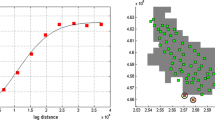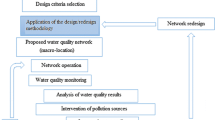Abstract
Within the recent EU Water Framework Directive and the modification introduced into national water-related legislation, monitoring assumes great importance in the frame of territorial managerial activities. Recently, a number of public environmental agencies have invested resources in planning improvements to existing monitoring networks. In effect, many reasons justify having a monitoring network that is optimally arranged in the territory of interest. In fact, modest or sparse coverage of the monitored area or redundancies and clustering of monitoring locations often make it impossible to provide the manager with sufficient knowledge for decision-making processes. The above mentioned are typical cases requiring optimal redesign of the whole network; fortunately, using appropriate stochastic or deterministic methods, it is possible to rearrange the existing network by eliminating, adding, or moving monitoring locations and producing the optimal arrangement with regard to specific managerial objectives. This paper describes a new software application, MSANOS, containing some spatial optimization methods selected as the most effective among those reported in literature. In the following, it is shown that MSANOS is actually able to carry out a complete redesign of an existing monitoring network in either the addition or the reduction sense. Both model-based and design-based objective functions have been embedded in the software with the option of choosing, case by case, the most suitable with regard to the available information and the managerial optimization objectives. Finally, two applications for testing the goodness of an existing monitoring network and the optimal reduction of an existing groundwater-level monitoring network of the aquifer of Tavoliere located in Apulia (South Italy), constrained to limit the information loss, are presented.











Similar content being viewed by others
References
Barca E, Passarella G, Lo Presti R, Masciale R, Vurro M (2006a) HarmoniRiB River Basin data documentation. Chapter 7 – Candelaro River Basin D6.3, pp 1–47
Barca E, Passarella G, Lo Presti R, Masciale R, Vurro M (2006b) Candelaro River Basin, Italy—A HarmoniRiB case study. HarmoniRiB project deliverables D7.6, pp 1–54
Barca E, Passarella G, Uricchio V (2008) Optimal extension of the rain gauge monitoring network of the Apulian regional consortium for crop protection. Environ Monit Assess 145(1–3):375–386
Barca E, Passarella G, Vurro M, Morea, A (2011) A software for optimal information based downsizing/upsizing of existing monitoring networks. In: Cafarelli B (ed) Spatial data methods for environmental and ecological processes, 2nd edn, Cdp Service Edizioni
Barca E, Passarella G, Vurro M, Morea A (2013a) Optimal redesign of groundwater monitoring networks: a data-driven multi-approach software. In: 8th Int Conf EWRA: Water Resources Management in an Interdisciplinary and Changing Context, Porto (PT)
Barca E, Calzolari MC, Passarella G, Ungaro F (2013b) Predicting shallow water table depth at regional scale: optimizing monitoring network in space and time. Water Resour Manag. doi:10.1007/s11269-013-0461-6 (first published online)
Bellman R (1954) The theory of dynamic programming. Bull Am Math Soc 60:503–515
Bellman R (1957) Dynamic programming. Princeton University Press, Princeton, Republished 2003, Dover. ISBN 0-486-42809-5
Bertsekas DP (1995) Dynamic programming and optimal control, Vol 1, No 2. Athena Scientific, Belmont
Bertsimas D, Tsitsiklis J (1993) Simulated annealing. Stat Sci 8(1):10–15
Castrignanò A, Morari F, Fiorentino C, Pagliarin C, Brenna S. (2008) Constrained optimization of spatial sampling in skeletal soils using EMI data and continuous simulated annealing, Proceeding of 1st Global Workshop on High Resolution Digital Soil Sensing & Mapping. 5–8 February 2008, Sydney – Australia (CD-ROM)
Christakos G, Killam BR (1993) Sampling design for classifying contaminant level using annealing search algorithms. Water Resour Res 29(12):4063–4076
Cressie NAC (1993) Statistics for spatial data. Wiley series in probability and mathematical statistics: applied probability and statistics. Wiley, New York
Cressie N, Gotway CA, Grondona MO (1990) Spatial prediction from networks. Chemometr Intell Lab Syst 7(3):251–271
Cunha MDC, Sousa J (1999) Water distribution network design optimization: simulated annealing approach. J Water Resour Plan Manag 125(4):215–221
D’Agostino V, Passarella G, Vurro M (1997) Assessment of the optimal sampling arrangement based on cokriging estimation variance reduction approach. In: Congr International Association of Hydraulic Research, IAHR, pp 246–252
D’Agostino V, Greene EA, Passarella G, Vurro M (1998) Spatial and temporal study of nitrate concentration in groundwater by means of coregionalization. Environ Geol 36(3/4):285–295
Delhomme JP (1978) Kriging in the hydrosciences. Adv Water Resour 1(5):251–266
Delhomme JP, Delfiner P (1973) Application du krigeage al ‘optimisation d’une campagne pluviometrique en zone aride’. In: Proc Symp Design of Water Resources Projects with Inadequate Data, Vol 2, pp 191–210
Deutsch CV, Cockerham PW (1994) Practical considerations in the application of simulated annealing to stochastic simulation. Math Geol 26:67–82
Di Zio S, Fontanella L, Ippoliti L (2004) Optimal spatial sampling schemes for environmental surveys. Environ Ecol Stat 11:397–414
Diggle P, Ribeiro P (2007) Model-based geostatistics. Springer, New York
Drosou M, Pitoura E (2009) Comparing diversity heuristics. Technical Report 2009–05. Computer Science Department, University of Ioannina
Dutta D, Gupta AD, Ramnarong V (1998) Design and optimization of a groundwater monitoring system using GIS and multicriteria decision analysis. Groundw Monit Remediat 18(1):139–147
Hajek B (1988) Cooling schedules for optimal annealing. Math Oper Res 13(2):311–329
Henderson D, Jacobson SH, Johnson AW (2003) The theory and practice of simulated annealing. In: Glover FW, Kochenberger GA (eds) Handbook of metaheuristics. Springer, US, pp 287–319
Hu MG, Wang JF (2011) A spatial sampling optimization package using MSN theory. Environ Model Software 26:546–548
Hughes JP, Lettenmaier DP (1981) Data requirements for kriging: estimation and network design. Water Resourc Res 17(6):1641–1650
Isaaks EH, Srivastava RM (1989) An introduction to applied geostatistics. Oxford University Press
Ishikawa H (2003) Exact optimization for Markov random fields with convex priors. IEEE Trans Pattern Anal Mach Intell 25(10):1333–1336
Journel AG, Huijbregts CJ (1978) Mining geostatistics. Academic press
Kirkpatrick S, Gelatt CD, Vecchi MP (1983) Optimization by simulated annealing. Science 220:671–680
Lo Presti R, Barca E, Passarella G (2010) A methodology for treating missing data applied to daily rainfall data in the Candelaro River Basin (Italy). Environ Monit Assess 160(1–4):1–22
Lobato FS, Assis EG, Steffen Jr V, da Silva Neto AJ (2012) Design and identification problems of rotor bearing systems using the simulated annealing algorithm. In: Sales Guerra Tsuzuki M (ed) Simulated Annealing—single and multiple objective problems. ISBN: 978-953-51-0767-5, InTech. doi: 10.5772/47833
Mandelbrot BB (1982) The fractal geometry of nature. Freeman, New York
Masciale R, Barca E, Passarella G (2011) A methodology for rapid assessment of the environmental status of the shallow aquifer of “Tavoliere di Puglia” (Southern Italy). Environ Monit Assess 177(1–4):245–261
Metropolis N, Rosenbluth A, Rosenbluth M, Teller A, Teller E (1953) Equation of state calculations by fast computing machines. J Chem Phys 21:1087–1092
Myers JC (1997) Geostatistical error management: quantifying uncertainty for environmental sampling and mapping. Wiley
Naoum S, Tsanis IK (2004) Integrating multicriteria analysis and GIS for assessing raingage worth within an established network. J Am Water Resourc Assoc 40(6):1449–1468
Nourani Y, Andresen B (1998) A comparison of simulated annealing cooling strategies. J Phys A: Math Gen 31(41):8373
Nunes LM, Cunha MC, Ribeiro L (2004) Groundwater monitoring network optimization with redundancy reduction. J Water Res Plan Manag 130(1):33–43
Nunes LM, Caeiro S, Cunha MC, Ribeiro L (2006) Optimal estuarine sediment monitoring network design with simulated annealing. J Environ Manag 78(3):294–304
Nunes LM, Paralta E, Cunha MC, Ribeiro L (2007) Comparison of variance‐reduction and space‐filling approaches for the design of environmental monitoring networks. Comput‐Aided Civ Infrastruct Eng 22(7):489–498
Ortner M, Descombes X, Zerubia J (2007) An adaptive simulated annealing cooling schedule for object detection in images. Rapport de recherche. RR n 6336
Pardo-Igùzquiza E (1998) Optimal selection of number and location of rainfall gauges for areal rainfall estimation using geostatistics and simulated annealing. J Hydrol 210:206–220
Passarella G, Vurro M, D’Agostino V, Giuliano G, Barcelona MJ (2002) A probabilistic methodology to assess the risk of groundwater quality degradation. Environ Monit Assess 79(1):57–74
Passarella G, Vurro M, D’Agostino V, Barcelona MJ (2003) Cokriging optimization of monitoring network configuration based on fuzzy and non-fuzzy variogram evaluation. Environ Monit Assess 82(1):1–21
Passarella G, Barca E, Lo Porto A (2006) Collection and elaboration of data for the pilot area of the Candelaro River (Italy). Development of completed database accompanied by appropriate software package for the retrieval, analysis and processing of flood related data. Description of the Candelaro Catchment. In: FloodMed project deliverables 2.2, pp 1–57
Rennen G (2009) Subset selection from large datasets for Kriging modelling. Struct Multidiscip Optim 38(6):545–569
Richey M (2010) The evolution of Markov Chain Monte Carlo methods. Am Math Mon 117(5):383–413
Rouhani S (1985) Variance reduction analysis. Water Resour Res 21(6):837–846
Stevens DL Jr (1997) Variable density grid‐based sampling designs for continuous spatial populations. Environmetrics 8(3):167–195
Stevens DL Jr (2006) Spatial properties of design-based versus model-based approaches to environmental sampling. In: Caetano M, Painho M (eds) 7th Int Symp Spatial Accuracy Assessment in Natural Resources and Environmental Sciences, p 119
Triki E, Collette Y, Siarry P (2005) A theoretical study on the behavior of simulated annealing leading to a new cooling schedule. Eur J Oper Res 166(1):77–92
Tsitsiklis JN (1989) Markov chains with rare transitions and simulated annealing. Math Oper Res 14(1):70–90
Van Groenigen JW, Stein A (1998) Spatial simulated annealing for constrained optimisation of spatial sampling schemes. J Environ Qual 27:1078–1086
Van Groenigen JW, Siderius W, Stein A (1999) Constrained optimisation of soil sampling for minimisation of the kriging variance. Geoderma 87:239–259
Van Groenigen JW, Pieters G, Stein A (2000) Optimizing spatial sampling for multivariate contamination in urban areas. Environmetrics 11:227–244
Van Laarhoven PJ, Aarts EH (1987) Simulated annealing. Springer, The Netherlands, pp 7–15
Winkel H, Stein A (1997) Optimal cost-effective sampling for monitoring and dredging of contaminated sediments. J Environ Qual 26:933–946
Acknowledgments
Water table data used in this paper have been collected within the project “TIZIANO” for the qualitative and quantitative monitoring of the regional groundwater bodies. Thanks are due to the Water Protection Department of the “Regione Puglia” who kindly provided the data.
Author information
Authors and Affiliations
Corresponding author
Rights and permissions
About this article
Cite this article
Barca, E., Passarella, G., Vurro, M. et al. MSANOS: Data-Driven, Multi-Approach Software for Optimal Redesign of Environmental Monitoring Networks. Water Resour Manage 29, 619–644 (2015). https://doi.org/10.1007/s11269-014-0859-9
Received:
Accepted:
Published:
Issue Date:
DOI: https://doi.org/10.1007/s11269-014-0859-9




